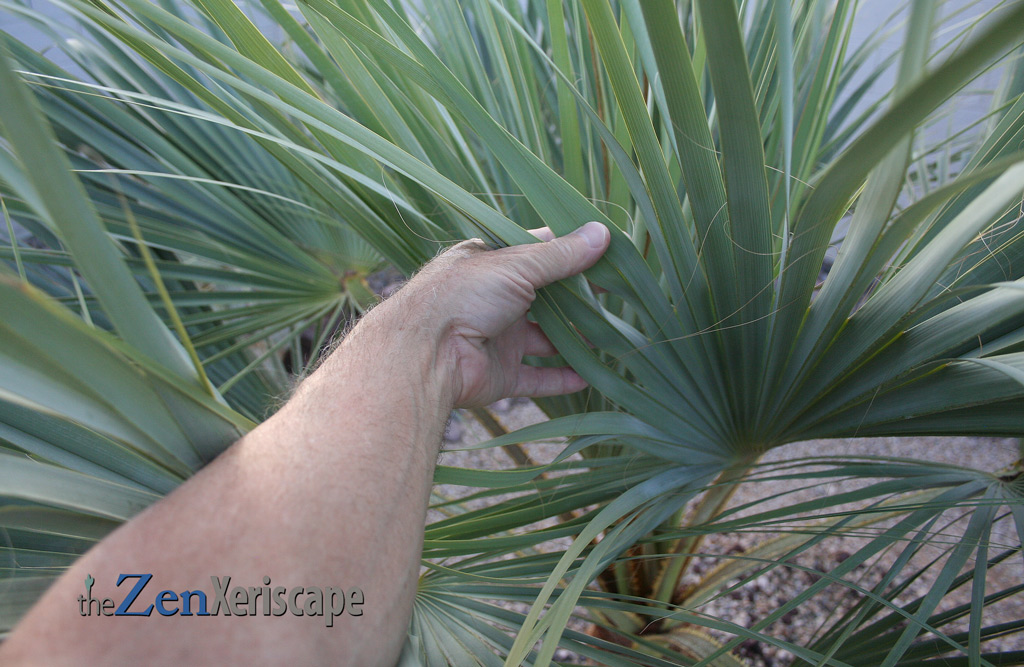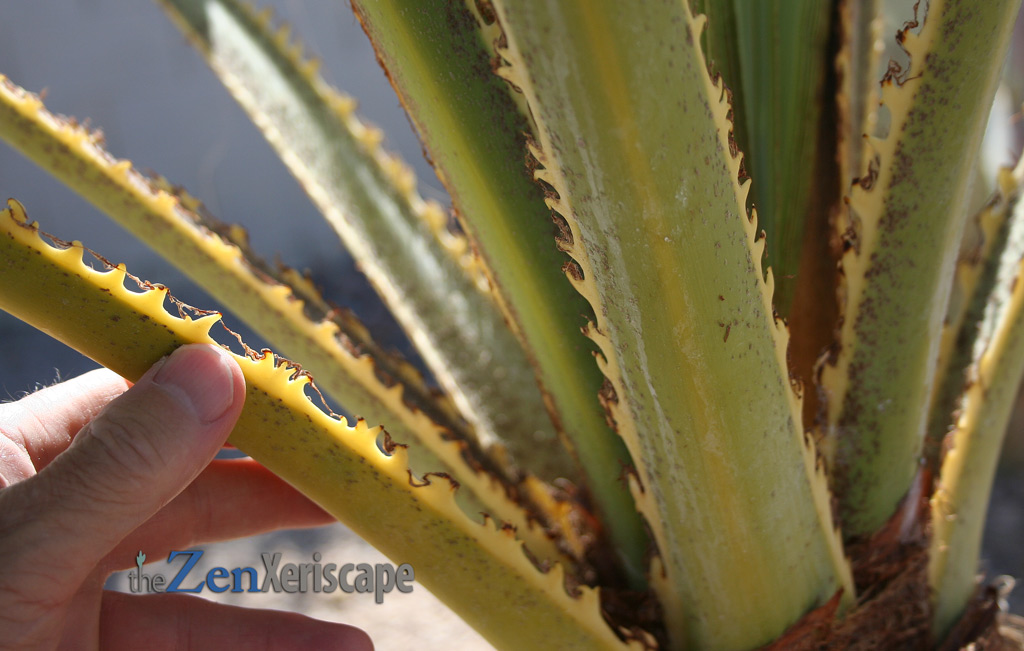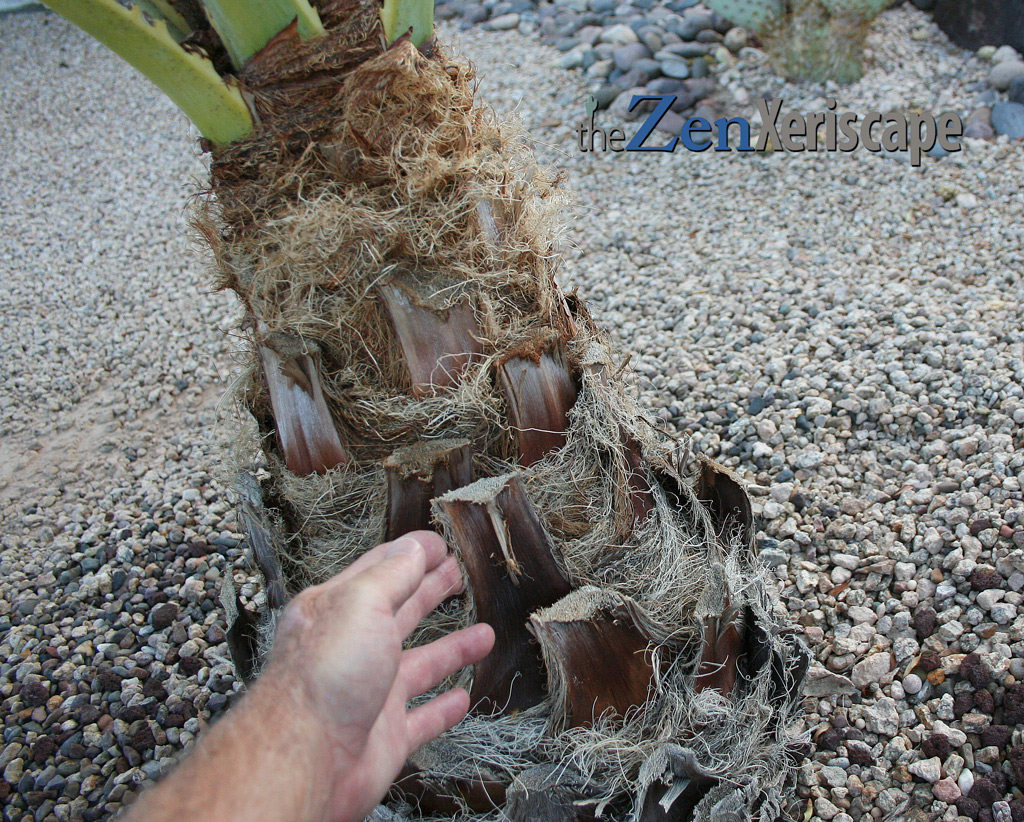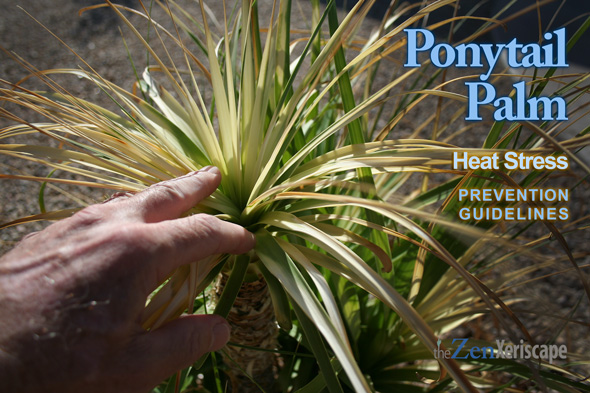I only have one Mexican Blue Palm (Brahea armata) in my landscape, but I wish I had more. They are a beautiful, exotic-looking palm tree that loves the desert heat, just like I do. However, would this palm tree work in your landscape? Read about the Mexican blue palm pros and cons, and then decide for yourself!

but its beauty makes it worth waiting for!
Photo by Doug Martin
Browse succulent potting mixes on Amazon! (As an Amazon Associate, I earn a commission from qualifying purchases.)
But first, let’s describe this beauty…
Mexican Blue Palm description
While this palm tree is slow growing, it can eventually reach a height of 30-to-50 feet. It has blue-green leaves that are toned down with a silver undertone—it’s a lovely and unique color. The leaves, or fronds, can last a few years before drying out
As this palm tree continues to grow, its trunk gets thicker. Eventually, it could get two-feet thick or more at its base.
Currently, I am not pruning the dried-up fronds very close to the trunk. But, in a few years, I plan on using an electric chain saw to give my Mexican blue palm a close shave (or scrape). Afterwards, the trunk will feel smoother, and improve the health of the tree.
This palm tree does flower eventually, and those small, creamy white flowers are grouped together in clusters (inflorescences) that are 20 inches or longer. The arching masses of inflorescences are very attractive, and afterwards the flowers produce yellow-orange berries, which have a hard seed surrounding by the fleshy fruit.
And now for the Mexican blue palm pros and cons…
Mexican Blue Palm pros and cons
PROS:
Heat and cold tolerant:
My Mexican blue palm looks great even in the 120 degree F southwestern summer heat. There are no signs of heat-stress, and it continues to push out new fronds from its center.
During the winter, my specimen has survived and looked great even when the temperatures dipped into the low 20s. However, your Mexican blue palm should survive temps as low as 15 degrees F.
Overall, this hardy palm tree will thrive in USDA hardiness zones of 9-to-11. But, if you live in zone 8, you might be okay with your winter’s low temps, too!
Drought tolerant:
In our southwestern summers, I believe this palm tree could survive with only once-a-month deep waterings. However, I water my younger palm tree specimen deeply once-a-week, mostly to encourage new growth.
And during the winter, once-a-month deep waterings will work well for this tree. As the tree continues to grow and mature, it will require less frequent waterings.
However, if you’re just planting this palm tree, water at least once-a-week (or more) until established. And the best times to plant are in the fall or early spring.
Stunning appearance:
The blue-green leaves create a nice contrast with other greener elements in an arid landscape. And when mature, the clusters of creamy-white flowers are eye-catching as they gracefully arch over and cascade parallel to the tree tunk.
The blue-green fronds and clusters of flowers create a uniquely beautiful and exotic sight in an arid landscape.

in a mostly green arid landscape.
Photo by Doug Martin
Today’s Amazon deals on potting soil! (As an Amazon Associate, I earn a commission from qualifying purchases.)
Low maintenance:
Just like many drought-tolerant plants, the Brahea armata requires low amounts of maintenance. The only upkeep I do is to prune off the lower fronds that are beginning to dry out.
I have never had any insect pests that ate or destroyed vegetation. This is a care-free, hardy palm tree that will work well in your xeriscape.
Long life:
Once you plant the Mexican blue palm, it could live for a 100 years or more! So, just plant it, enjoy it, and don’t worry about it.
Versatile uses:
Plant this tree directly in your landscape, or plant it in a large container. Because it grows slowly, it will remain happy in a container for a decade or more.
My neighbor planted one in a large, beautiful planter near her pool. The rippling, shimmering water of the pool perfectly complement the blue-green palm fronds as they wave in the breeze. It’s been in the same container for at least eight years, and still looks wonderful.
Mexican Blue Palm pros and cons
CONS:
Grows slowly:
Unlike the Mexican fan palm which can grow three feet per year, the Mexican blue palm grows extremely slow. I have a specimen, and it has only grown about one foot of trunk height in the past seven years.
So don’t expect immediate gratification if you plant this palm tree in your landscape. However, even though it does grow slowly, it still adds a uniquely exotic look to your landscape.
Sharp leaf-stalk edges:
The leaf-stalk edges, or petioles, have sharp points that look like teeth. The points look rounded, but they are very sharp.
When pruning, use gloves or be cautious when handling, because they can quickly and easily puncture skin. Unfortunately, I know that fact by harsh experience!

Use gloves when pruning fronds.
Photo by Doug Martin
Browse landscaping design books on Amazon for new ideas! (As an Amazon Associate, I earn a commission from qualifying purchases.)
Does not like high humidity:
Apparently, the Mexican blue fan palm does not thrive in the high humidity that is common in the southeastern United States. In high humidity, this palm tree is prone to bud rot.
If you live in southeastern United States and have successfully grown a Mexican blue palm, please let us know your experiences in the comment section below!
Sensitive to root disturbance:
Once this palm tree becomes established with a healthy root system, transplanting can be difficult. So, carefully choose where you locate this palm in your landscape for the best long-term success.
Or, plant it in a container or large planter. Then, you can move it around in your landscape without disturbing its roots.

to remove the old, dried out stalks.
This process will make the trunk smoother
and more attractive.
Photo by Doug Martin
Explore the free trial plans for Prime! (As an Amazon Associate, I earn a commission from qualifying purchases.)
Takeaways:
Mexican blue palm pros and cons
I love my Mexican blue palm tree. While it is still relatively small, it already adds an exotic element to my landscape. As each year goes by, it will continue to look better and better.
It is drought- and heat-tolerant, which are vital characteristics for any arid landscape. And, it is low maintenance.
My only regret is that I didn’t plant more in my landscape ten years ago. That would have been great! Maybe I can still plant a couple more Mexican blue palms.
Content and photos by Doug Martin and The Zen Xeriscape.



